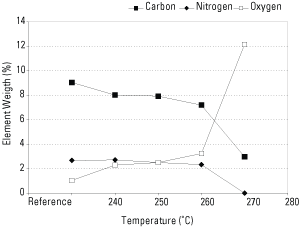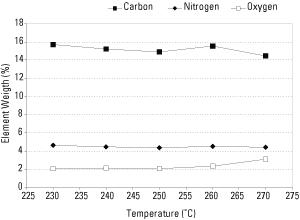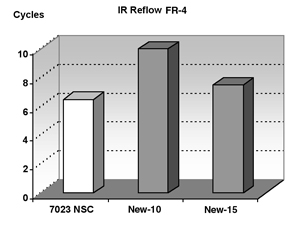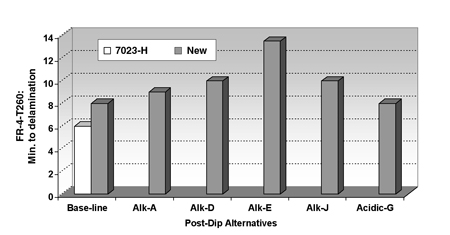Increased high temperature stability enhances adhesion in RoHS compliant laminate materials.
The industry requirement to meet the demands of lead-free applications has challenged many areas of PCB fabrication and design. This has incited a rapid influx of new and improved dielectric materials that must remain effectively bonded to the copper innerlayers.
Delamination failures in advanced multilayer and sequential-build products, caused by the conversion to lead-free soldering, has driven the need for improved oxide replacement technology. Such a product must resist challenging peak temperatures – some 30°C higher than the old leaded eutectic application. Based on statistically designed experiments, a new process has been developed that delivers a more resilient copper conversion coating. This has shown improved bonding performance and greater stability at higher temperatures, thus improving its capability to meet more thermal excursions, e.g. assembly-reflow cycles at >260°C, without failure. This article focuses on the development criteria and performance evaluation, including data on peel strength, solder float and IR-reflow testing. Benchmarking is described against two standard oxide replacement products.
Sulfuric-peroxide-based “alternative oxide” technologies have become the industry standard, having widely replaced the traditional reduced black oxide processes for innerlayer bonding. These lower cost processes, based on an organically controlled microetch, have proven to be simpler, faster and more energy efficient as well as providing a lower cost of ownership for the fabricator. The resulting enriched cuprous oxide (Cu2O)-based organic conversion coating has provided improved physical strength and much greater acid resistance compared to the 100% cupric oxide (CuO) coatings (comprised of dendritic crystals), generated by the older black oxide processes. The acidic nature of the sulfuric-peroxide processes has also eliminated the propensity to high resistance shorts with fine line innerlayer HDI product. This had become a major weakness of traditional reduced oxide process due to the heavy oxide precipitation associated with the alkaline-chlorite chemistry. As a direct result, the newer sulfuric-peroxide technology has been better able to support the growth of higher density/higher layer count products. The alternative oxide chemistry has also delivered improved bonding performance with the more advanced materials, including higher Tg and lower Dk dielectrics – both of which have paved the way for the necessary increases in interconnect densities in high performance applications.
The recent industry shift towards lead-free technology has brought renewed challenges to the whole spectrum of PCB designs and manufacturing processes. With the peak assembly soldering temperatures (IR and wave) operating in the range of 255 to 265°C, and some 30 to 35°C higher than with conventional eutectic solder product, the thermal and mechanical stresses on the PCB are substantial. This shift has compelled the introduction of a whole new range of more thermally stable dielectric/resin systems. A good example is the influx of Phenolic-cured FR-4 epoxy products to replace the less stable DICY-cured counterparts. Many of the new resin-based materials also have much greater chemical resistance, which can be seen not only in the rates of desmear etchback, but also in the increased difficulty to texture the hole-wall to ensure good metallization integrity.
These properties have clear relevance to the case in point, i.e. the innerlayer copper-to-dielectric bond. The organo-conversion coating designed to enhance this adhesion is therefore further challenged, not only by the increased stresses but also by the chemical resilience of the new materials. Taking into consideration the growth of sequential build-up products, which have one or two additional thermal lamination cycles incorporating dense clusters of blind microvias, the innerlayer bonds have already experienced significant thermal stress before the assembly cycle commences. When multiple lead-free assembly IR-reflow excursions are added to this, the net result can be a delamination of the prepreg-to-prepreg and/or the copper-to-prepreg planes. It is not surprising that many OEMs and EMS providers, who build advanced HDI products, are specifying a need to pass up to 10x IR-reflow cycles in order to ensure that their products can be assembled with the requisite high yields and reliability.
Let’s review a research initiative that was executed to develop an improved oxide alternative that would meet and exceed the advanced application requirements of such lead-free technologies.
Experimental
The research project to be described has been aimed at further improving both the thermal integrity and the adhesion quality of the existing organo-metallic conversion coating in order to improve lamination resilience during exposure to elevated temperatures (260 to 280°C). The lamination quality and integrity is clearly impacted not only by the copper-to-dielectric bond, but also by a range of material and process factors that extend well beyond the direct influence of the copper conversion coating. The contribution of the actual laminate type/quality, the press/lamination conditions and the type of copper substrate were beyond the scope of this initial study, and were maintained as constant as possible to minimize any noise. The performance appraisal incorporated the use of standardized methodologies.
While the primary strategy was to evolve a more thermally resistant conversion coating, the approach to optimize the overall alternative oxide (system) performance was based on an integral method that looked at all the process steps. These included the microetch, cleaner/conditoner, the oxide replacement bath itself, and also the post-dip treatment designed to further improve the acid resistance of the surface and eliminate any propensity towards pink ring formation. Benchmarking was made against the adhesion performance of two standard oxide replacement products.
|

FIGURE 1. EDAX composition of standard oxide alternative after various IR-reflow peak temperatures.
|
The preliminary study first looked at the simple effect of temperature on a standard product coating under normal atmospheric conditions. Since the typical lead-free soldering temperature has been increased to values around 260°C, the impact of the higher thermal stress conditions on coating composition (measured as carbon, nitrogen and oxygen levels) is shown in Figure 1. Also noted, but not shown in this context, was the significant color change recorded at temperatures above 260°C. Up to this temperature, the standard conversion coating is a uniform dark brown. Between 260 and 270°C, this color changes to a uniform gray. Clearly, some coating oxidation or chemical modification takes place at higher soldering temperatures and it is therefore reasonable to expect that this change correlates with the adhesion performance. While it is also expected that the behavior of the coating in a bonded (encapsulated) condition may be tempered due to the absence of excess free oxygen, changes in color of the such bonded coating can also be clearly detected under repeated reflow test conditions.
The observed composition/color change vs. soldering temperature was assumed to be a reasonable “measurable.” This was used for screening potential approaches, leading to an improved process performance; i.e. constant color and coating composition at temperatures of 260°C or greater, correlates with good adhesion performance of the improved alternative oxide system. Using this screening option, a project path was defined that incorporated the use of an additional organic compound. Based on this preliminary revison, the composition after IR-reflow was independent of peak-temperatures up to 270°C (Figure 2). In addition, only a minor color change was observed by passing from 260 to 270°C.
|

FIGURE 2. EDAX composition of new oxide alternative after various IR-reflow peak temperatures.
|
After defining the project approach, the next step was a statistical optimization of the new process chemistry, based on a Taguchi L9 experimental plan. Four component parameters, each adjusted at three levels, were investigated (Table 1 [PDF format]). The experimental plan was defined according to standardized Taguchi test plans.
The temperature performance of the bonded test vehicles was evaluated by using a simulated IR-reflow test and also by a solder dip (cyclic test) at 260°C, 270°C and 280°C. Coating color, peel strength and etch rate also formed part of the performance characterization. Standard 140 Tg FR-4 substrates were used at this stage of the investigation and standard process conditions were applied for the lamination cycle. All the experiments, including those comparing the reference data from the two standard benchmarking processes, were made on a laboratory scale. Peel strengths and etch rates were measured according to standardized methods.
Test Results
The results of the first screening DOE showed that the response data from the performance testing was highly dependent on the presence of the new organic compound (Org-1 in Table 2 [PDF format]). Also of importance was the adjustment of the chloride concentration. The addition of a second potentially beneficial organic compound (Org-2 in Table 2) did not contribute significantly to the performance of the coating and was not critical to the newly formulated process. Optimal performance of the coating was expected when the chloride concentration was held at the lower end of the concentration range investigated. By contrast, it was found that the concentration of the organic compound Org-1 required adjustment towards the higher end of the range. The best overall delamination resistance was achieved without a post-dip treatment.
Note: The ANOVA e-factor was within aceptable ranges except for FR-4 T260 (solder dip) and IR-reflow. However the Taguchi figures indicated the presence of interactions between some process parameters. A Taguchi L9 orthogonal array assumes no interaction between each parameter and, if present, the e-factor increases and the validity of Taguchi calculations decreases.
Verification
Based on the information derived from the previous Taguchi experiments, two optimum process configurations were chosen for further investigation (the abbrevations New-10 and New-15 were used). The cycles to delamination, achieved during repeated solder dip testing (at 270 and 280°C) without post-dip are shown in Table 3 [PDF format]. The peel strength results and cycles to delamination at 270°C (peak temperature for IR-reflow) are shown in Figures 3 and 4.
|

FIGURE 3. Benchmarking peel strength (n=4) for two new high temperature oxide alternative versions.
|
|

FIGURE 4. Benchmarking cycles to delamination (n=5) for two new high temperature oxide alternative versions.
|
Effect of Post-Treatment
As previously described, a post-treatment of the conversion coating formed during oxide alternative treatment can be made in order to further increase acid resistance and prevent formation of micro wedge-voids on laser drilled blind vias, during the subsequent plating operations. The resulting surface analysis, before and after post-treatment, typically shows changes in composition and a further increase in the ratio of cuprous oxide to cupric oxide. The amounts of carbon, nitrogen and oxygen are also seen to decrease after a post-dip. Most importantly, the chloride is removed completely from the coating. It is, therefore, to be expected that such a change in composition will correlate with a change in delamination performance. In general, the post treatment of the standard coating results in a significant increase in peel strength, typically of 10 to 20%, but also gives rise to an inferior delamination performance. In such cases the peel values may start very high but reduce much more quickly with successive reflow cycles. For this reason the initial peel values obtained from a single lamination cycle are of little value in predicting total delamination resistance and final assembly performance.
The alternative chemistry was further evaluated for post-treatment performance using standard (baseline) and modified post dips, which were developed as part of the total process concept by using time to delamination (Figure 5). With the appropriate chemistry adjustments, the ability to withstand delamination during cyclic solder dip testing was increased significantly over the standard. In Figure 4, the “new” product was an optimized version developed during the preliminary study and formed the precursor for the development of New-10 and New-15.
|

FIGURE 5. Time to delamination at 260°C (solder dip) for new AlphaPrep after different post-dip treatments.
|
Surface Structuring
Part of the research strategy had been to optimize the surface morphology/topography of the copper through an enhanced microetch pre-treatment. Surface topography adds another variable to the overall adhesion performance, as the copper surface structure clearly influences the adhesion in a physical way. During the research, various new microetching chemistries were tested and a modified process was developed to optimize the contribution to the surface texture imparted by the process.
Validation Study
The overall performance of the newly developed microetch, together with a new alkaline cleaner (not described in this context) and also a new post-dip chemistry, was investigated in a validation study in combination with a standard oxide replacement (reference). The evaluation of adhesion was made using cycles to delamination during solder dipping at 270°C. The performance of various combinations of new chemistry is shown in Table 4 [PDF format]. The reference was based on the existing microetch, alkaline cleaner and post-dip in use today with the standard process.
The solder float T270 performance was doubled (experiment #1 vs. #2 in Table 4) by using more optimized pre- and post-treatment chemistry, i.e. microetch, alkaline cleaner and post-dip. However, applying a post-dip still reduced the overall process performance (#2 vs. #3-4).
Scale-Up Verification
The new high temperature process performance was then tested on a larger scale. A vertical pilot-line was used and all the test boards processed were evaluated by a major PCB fabricator. Various laminate cores were processed using resin coated (RCC) foils (supplier A), HTE-foils (suppliers B and C) and prepreg (suppliers B, C and D). No post-treatment was included in this first control study. For all test boards, the number of cycles to delamination was between 10 and 15 (IR-reflow) lead-free conditions with a peak of approximately 260°C.
Extensive performance evaluations under production conditions (horizontal processing) have been completed and preliminary results have shown a uniform color and low etch rate (1.1µm/min) immediately after start-up. A second production trial, including the new post-dip process, is also running.
Summary
A new process for high temperature applications, consisting of optimized microetch, alkaline conditioner, oxide alternative bath and post-dip, has been developed and demonstrated to improve delamination resistance on a pilot scale. Process performance, measured as peel strength, and time to delamination (solder-dip and IR-reflow simulation) have both shown a significant improvement. The new, improved adhesion promoter is now being tested under more rigorous industrial production conditions. The primary factors that were instrumental in delivering improved performance included the incorporation of a second organic material to the oxide alternative and the appropriate optimization of the chloride. The lack of correlation between initial peel strength (one lamination) and subsequent delamination performance questions again the reliability of peel testing as a suitable measure of performance. Further work is planned to find a more reliable alternative measure. PCD&M
Ed. – AlphaPREP® is a registed trademark of Enthone Inc.
Dr. J. Rasmussen is an R&D manager, D. Isik is a research chemist, Dr. A. Dombert is the global product line manager – process chemistry, and D. Ormerod is business director – PCB metallization at Enthone Inc. They can be reached at This email address is being protected from spambots. You need JavaScript enabled to view it.. Dr. A. Owei is president and principle scientist at Avo Tech International Inc. He can be reached at This email address is being protected from spambots. You need JavaScript enabled to view it..


















